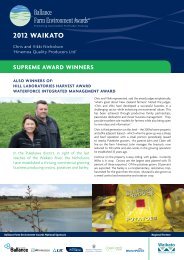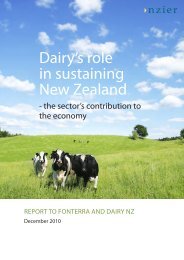Hearing Evidence – Brunner - Federated Farmers
Hearing Evidence – Brunner - Federated Farmers
Hearing Evidence – Brunner - Federated Farmers
You also want an ePaper? Increase the reach of your titles
YUMPU automatically turns print PDFs into web optimized ePapers that Google loves.
these expenses are sourced locally and relate to labour, contractor and professional<br />
fees, bought in feed, and other local services. Using the Southland model as a guide,<br />
we estimate that the increase of 5250 cows milked on the West Coast reported in the<br />
2011/2012 year, represents an additional $6,777,500 in farm working expenses, the<br />
majority of which directly enters the local economy. Added to the benefits generated<br />
on-farm, almost all milk produced on West Coast Farms is processed locally at<br />
Westland Milk products, a major employer in the region. In other words, reducing<br />
opportunities for farm production, has a directly proportional effect on jobs and<br />
opportunities for enterprising West Coasters.<br />
Relationship between impacts on farm values and stewardship<br />
25. Methods that undermine farm value, will also undermine the sense of ownership of<br />
farms and environmental issues related to them. This is important because voluntary<br />
methods and facilitating behavioral change have already proven very valuable in<br />
managing nutrient inputs to <strong>Brunner</strong> and are an aspect of the ethic of stewardship,<br />
which the Council is required to ‘have particular regard to’ under section 7 (aa) of the<br />
RMA. We think that the following from the section 32 report for the proposed Land and<br />
Water Plan, produced at the time of notification fairly reflects the value of voluntary<br />
action in improving farm practice in the Lake <strong>Brunner</strong> catchment:<br />
Farm plans had been developed with farmers in the catchment in 2005. These<br />
were a non-regulatory approach to improving systems of which some farmers had<br />
implemented the recommended best practice. Good work was undertaken by<br />
landowners through the installation of fencing and bridging, but unfortunately not<br />
everyone participated in this project. With new landowners in the catchment and<br />
changes in policy proposed, a review of these plans would provide new<br />
opportunities for reducing adverse effects on the environment through current<br />
farming practice.<br />
This method is seen as a positive approach towards identifying and working with<br />
landowners to come up with solutions and timeframes for putting in place best<br />
practice systems which not only benefits the landowners, but also has a positive<br />
environmental benefit. It is also another opportunity for farmers to demonstrate the<br />
value of non-regulatory tools in achieving positive change.<br />
26. Contrary to the submission of Fish and Game discussed at Decision Requested: 9.54,<br />
we see farm plans and education as effective in achieving improvements. Widespread<br />
support for improved effluent management, stock exclusion and stock crossings to<br />
reduce P loss are evidence of the ability of farmers to change once properly equipped<br />
with appropriate information.<br />
6
















